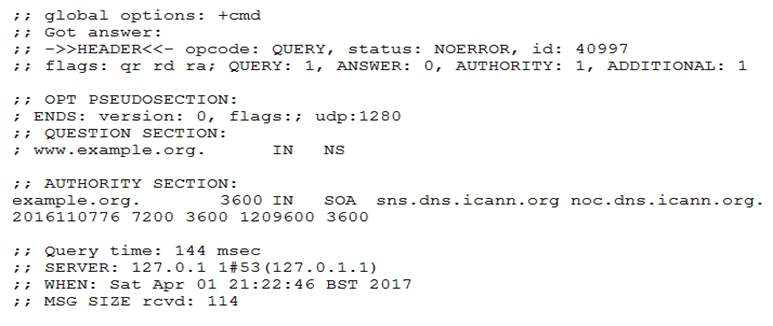Which of the commands below might have produced the following output?

Which of the commands below might have produced the following output?

The output in the image shows that the query type is 'NS', which stands for Name Server records. The 'QUESTION SECTION' confirms this as it lists 'www.example.org. IN NS', indicating a query specifically for NS records. Therefore, the command 'dig -t ns www.example.org' is the one that could have produced the output shown.
Correct Answer is "C" tested B and E all wrong QUESTION SECTION: ;www.example.org. IN NS
yep, that's right.
The correct answer is : dig -t ns www.example.org as shown in the printed output, just look at "QUESTION SECTION: www.example.org. IN NS"
Definitely "C". Look at the line: ;; QUESTION SECTION: ;www.example.org. IN NS "NS" is the key
C is right , I tested on Ubuntu: $ dig -t ns www.google.com the result is correct
use the @ Google to respond to query... then I found out after a long research that: dig @8.8.8.8 -t NS www.example.com gives that exactly what in the picture The local caching resolver seams to gives another answear. Tricky question.
This was in the exam. All questions are valid, These dumps helped a lot
The correct Answer is C
Correct is "E".
C is correct Man dig -t type This option indicates the resource record type to query, which can be any valid query type. If it is a resource record type supported in BIND 9, it can be given by the type mnemonic (such as NS or AAAA). The default query type is A, unless the -x option is supplied to indicate a reverse lookup. A zone transfer can be requested by specifying a type of AXFR. When an incremental zone transfer (IXFR) is required , set the type to ixfr=N. The incremental zone transfer contains all changes made to the zone since the serial number in the zone's SOA record was N. All resource record types can be expressed as TYPEnn, where nn is the number of the type. If the resource record type is not supported in BIND 9, the result is displayed as described in RFC 3597.
C is correct, tested them all and each output yielded depended on the type mnemonic (NS or AAAA). check man page -t type section to confirm :)
the correct answer is C
Tested in Debian
the correct answer is C. Tested on Centos 7
C is the right answer
Tested on both Debian and Centos 7, it should n ot matter what Linux distro as the DIG command us common across all distros
Answer is C
C is correct, it is only one that produced a result including "IN NS"